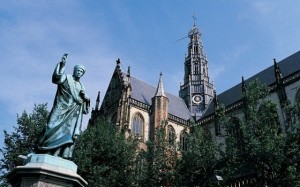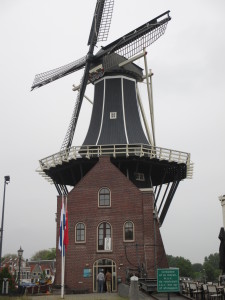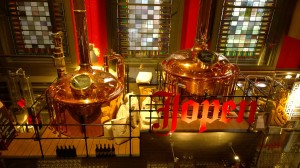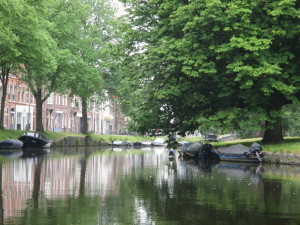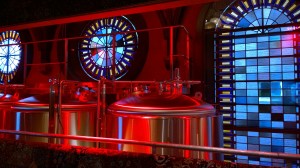OLANDA
L’Italia è bellissima, un museo a cielo aperto, cibo da sballo e un mare che mezzo mondo ci invidia, eppure l’Olanda è un paese dove ogni volta che ci vado sono felice. La vita è slow, gli olandesi sono di una gentilezza commovente, le città e le cittadine sono a misura d’uomo, senza il traffico caotico delle auto, con treni e tram sempre in orario perfetto, un canale da navigare e delle casette che sembrano quelle della bambole tanto sono carine e curate con deliziosi oggettini e tanti fiori davanti alla porta e sui davanzali delle finestre. Non c’è un vu cumprà, non c’è un clochard, tutto è pulito, lindo e ordinato. Il bello dell’Olanda è che tutti rispettano le regole e quindi tutti stanno bene.
Mi ero già innamorata di Utrecht, ora ho perso il cuore per Haarlem, A 20 minuti in treno da Amsterdam (fra l’altro la stazione è un bell’esempio di Art Noveau, Haarlem (scritto propio con 2 a e che ha dato il nome al famoso quartiere di colore di New York) è una città del XVII secolo conservata meravigliosamente, che si gira a piedi o in bicicletta ricordando però che in Olanda per frenare si usano i pedali e, volendo, si visita anche in barca visto che è attraversata dal fiume Spaarne. A proposito del fiume, guai a perdersi una gita fino al mulino a vento nero, chiamato De Adrian. E’ un simbolo della città, bruciato un paio di volte, è stato sempre ricostruito e ora ospita un grazioso ristorante.
Musei ad Haarlem? Quanti se ne vuole, a cominciare da quello dedicato al grande maestro Frans Hals (considerato secondo solo a Rembrendt) che contiene una collezione incredibile di quadri di grandi pittori olandesi, fino al Teylers (l’antica casa di Pieter Van del Hulst Teylers ricco mercante di tessuti e filantropo) in cui si trovano, oltre a invenzioni del passato, minerali e fossili, anche 25 mila stampe e 10 mila disegni tra cui alcune opere di Michelangelo , Raffaello e di Rembrandt. Il turista curioso potrebbe chiedersi perchè in Olanda ci sono così tanti quadri e la spiegazione viene da Monique van Royen del Frans Hals Museum che racconta come nel 1600 fossero stati dipinti ben 10 milioni di quadri a fronte di una popolazione di 2 milioni di abitanti: gli abitanti di Haarlem amavano talmente i dipinti che li compravano in quantità per tapezzare i muri. Anche i poveri compravano, ma solo poster. E infatti ad Haarlem era molto diffusa la stampa tanto che viene attribuita a Laurens Jaszoon -di cui si può vedere la statua nella piazza principale la Grote Mark– l’invenzione della macchina da stampa 16 anni prima di Gutemberg.
Chi ama la musica rimane a bocca aperta davanti all’organo del XVI secolo che troneggia nella tardogotica Grote Kerk. Uno strumento musicale talmente imponente e perfetto che Hendel durante un suo viaggio fece una deviazione proprio per poterlo suonare.
Dicevo prima, una città slow. Una città che nel 1600 aveva 150 birrifici. Oggi molto meno, ma la birra che si beve nella chiesa sconsacrata Jopenkerk è divina. Il birrificio produce 36 tipi di birre, alcune veramente uniche e tutte comunque da provare e qualcuna da comprare e portare a casa come souvernir.
Per dormire e mangiare non c’è che l’imbarazzo della scelta: si sta benissimo al Amrath Grand Gotel Frans Hals e se volete un suggerimento per un lunch veloce ma gustosissimo provate la Brasserie Nobel: il pane nero col salmone ha un sapore indimenticabile. Quando andarci? Sempre, però se in agosto siete da queste parti non perdetevi il Bloementapjit, una manifestazione nata per celebrare il ruolo di Haaarlem nella coltivazione dei tulipani i cui splendidi campi colorano il paesaggio circostante. Per info: http://www.haarlemmarketing.co.uk/; www.holland.com/it/turismo.htm
Italy is beautiful, an open-air museum, food and a rocking sea that half the world envies us, but the Netherlands is a country where every time I go there I’m happy. Life is slow, the Dutch are a moving kindness, cities and towns are on a human scale, without the chaotic traffic of cars, trains and trams always in perfect time, a channel to navigate and the houses that seem those of the dolls are so cute and delicious cured with trinkets and lots of flowers in front of the door and on the window sills. There isn’t a vu cumprà , there isn’t a homeless man, everything is clean, neat and tidy. The beauty of Holland is that everyone respects the rules and therefore everyone is well.
I was already in love with Utrecht, now I lost my heart to Haarlem, 20 minutes by train from Amsterdam (among other things the station is a fine example of Art Nouveau architecture, Haarlem (written propio with 2 to and which gave its name the popular district of color in New York) is a city of the seventeenth century beautifully preserved, which turns walking or cycling remembering that in the Netherlands to stop using the pedals and, if desired, you visit also by boat since it is crossed from the river Spaarne. About the river, woe to miss a trip to the windmill black, called De Adrian. It is a symbol of the city, burned a few times, it was always rebuilt and now houses a nice restaurant.
Museums in Haarlem? How many you want, starting with one dedicated to the great master Frans Hals (considered second only to Rembrandt’s) that contains an incredible collection of paintings by great Dutch painters, until the Teylers (the former home of Pieter Van Hulst of Teylers wealthy merchant fabrics and philanthropist) in which they are located, as well as inventions of the past, minerals and fossils, even 25,000 prints and 10,000 drawings including works by Michelangelo, Raphael and Rembrandt. The curious visitor might wonder why in the Netherlands there are so many paintings and the explanation comes from Monique van Royen the Frans Hals Museum, which tells how in 1600 they had been painted as many as 10 million square against a population of 2 million people, the inhabitants of Haarlem so loved the paintings that were buying them in quantity for tapezzare walls. Even the poor were buying, but only poster. And in fact in Haarlem was widespread printing much that is attributed to Laurens Jaszoon -of which you can see the statue in the main square the Grote Mark-the invention of the printing press 16 years before Gutenberg.
Music lovers remains speechless before the organ of the sixteenth century which dominates the late Gothic Grote Kerk. A musical instrument so impressive and perfect that Hendel during a trip he made a detour just to be able to play.
I said above, a slow city. A city that in 1600 had 150 breweries. Today much less, but the beer you drink in the deconsecrated church Jopenkerk is divine. The brewery produces 36 types of beers, some truly unique, and all made to try and some to buy and take home as souvernir.
To sleep and eat there will be spoiled for choice: I had a great time at the Amrath Grand Gotel Frans Hals and if you want a suggestion for a quick but tasty lunch try the Brasserie Nobel: black bread with salmon tastes unforgettable. How to visit? Increasingly, however, if you are in August around here don’t miss the Bloementapijt, an event created to celebrate the role of Haarlem in the cultivation of tulips, whose splendid fields color the landascape.
Testi e foto di Graziella Leporati



